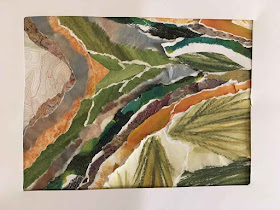In the midst of these musings, I read about Irvin Trujillo's latest Best in Show weaving at Santa Fe's annual Spanish Market. The piece is entitled Pensando en el Cajon or Thinking in the Box. As you would expect from Irvin, the piece was breathtakingly complex and exquisitely crafted. His words quoted in the Santa Fe New Mexican newspaper article caught my attention:
"Irvin Trujillo, in discussing his winning piece, explained that while most artists are told to think outside the box, his weaving explores the concept of the box by going back to traditional roots.
'The box hasn't been defined yet,' he said of his textile, which took eight months to create. 'So we have to figure out the box before going outside.'"
 |
| Irvin Trujillo of La Centinela Weavers in Chimayo, NM, describes his winning piece to Barbara Crowley of Maine at the preview for Spanish Market. Photo by Luis Sanchez Saturno of The New Mexican |
Wow! Irvin comes from seven generations of Rio Grande weavers, and he feels the box hasn't been defined yet! I am going to ponder that thought for quite a while. Irvin's words, and even more, his stunning weaving, confirm that there is still plenty to be discovered and achieved inside the traditional box of weft-faced weaving, and within the various traditions within the tapestry field (Rio Grande, French, Navajo and others. . .). Treat yourself and hop over HERE to see some of Irvin's work. And of course the art of many other contemporary tapestry weavers who work within the parameters of pure tapestry also affirms this. For proof of this, look no further than the member artists of the American Tapestry Alliance.
Many of us have discovered that working within limits can be paradoxically freeing and actually lead us to find new solutions for creative problems. On the most basic level, if you've ever run out of a particular type or color of irreplaceable yarn before you've finished weaving, you know what I mean. You have to find new solutions within the parameters you're working in, and often those solutions make for a more interesting piece in the end.
So, where does that leave me (and maybe you?), a contemporary weaver, excited by the modern anything-goes approach yet impressed and informed by what is possible in the traditional manner?
Darned if I know! I'm headed back to the studio to see if I can find out where my work lies in relation to the box. . . . Meanwhile, let me know in the comments--is your work inside the box? Outside? How does your conception of your relation to the box inform your work?






